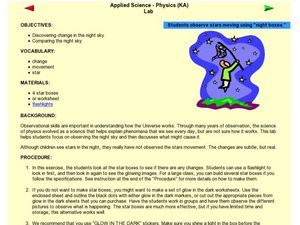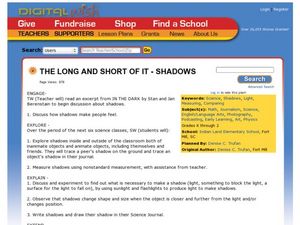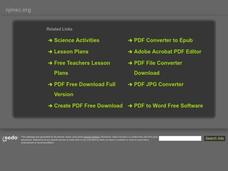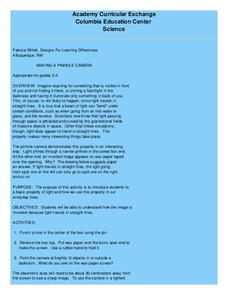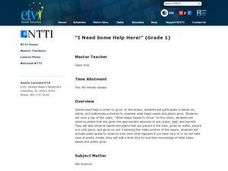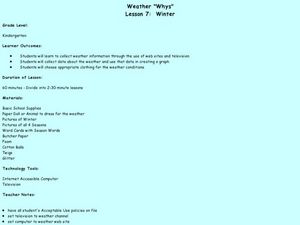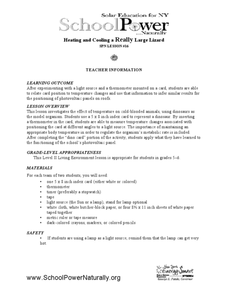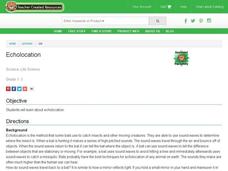Curated OER
Light Plants and Dark Plants, Wet Plants and Dry Ones
Young scholars plant sunflower seeds in plastic cups, and once germinated, these are exposed to different conditions of light levels and/or soil moisture contents. Students measure growth of the seedlings every few days using...
Curated OER
Light and Shadows
Students observe and record the apperacne of shadows and how their position and shpae changes during the course of the day. Students measure and record the length oof a partner's shadow at different intervals during the day. In pairs,...
Curated OER
How Long is the Day? Counting Day Light Hours
In this daylight hours worksheet, students calculate the number of daylight hours at different locations around the world. This worksheet has 3 fill in the blank questions.
Curated OER
Light at the Bottom of the Deep, Dark Ocean?
High schoolers participate in an inquiry activity. They relate the structure of an appendage to its function. They describe how a deepwater organism to its environment without bright light.
Curated OER
Cool Lights
Students investigate how and why deep-sea organisms produce light. They examine how these processes can be used to study deep ocean environments.
Curated OER
Polarized Light
Learners examine polarized light and that it can be done through reflection. In this reflection lesson plan students develop a model that accounts for differences in light behavior.
Curated OER
Photosynthesis
Students conduct experiments with plants. In this photosynthesis lesson, students examine plants under different types of lights. They calculate the amount of dissolved ocygen concentration and compare it to the formula for...
K5 Learning
The Sun and the Stars
How are the stars similar to the sun in our galaxy? Learn all about the solar system with a reading excerpt about the sun and the stars. Kids read an informational passage before they answer questions about reading comprehension,...
Curated OER
Night Sky Observation
Students explore space science by completing an observational worksheet. In this astronomy lesson, students view several worksheets in which students identify minor changes between separate images in preparation for real star...
Curated OER
Lightning in a Jar
Young scholars create lightning with two common objects and observe the colorful "discharge" of electrons on a smaller scale. By exploring the phenomena of static electricity, students relate their knowledge to the real-life weather...
Curated OER
What a Fungi
Seventh graders perform an experiment to determine the best growing conditions for molds. In this life science lesson, 7th graders explain where molds are commonly found. They collect data and draw diagrams of their observations.
Curated OER
The Long and Short of It- Shadows
Students trace shadows. In this light and shadows lesson, students conduct an experiment to determine what a shadow is and what is necessary to make a shadow. Students observe how shadows change as well as write and draw shadows in their...
Curated OER
Classification and Identification
Students, after exploring and analyzing diagrammatic and taxonomic keys and their association to marine sciences, identify and classify objects and organisms based on visual attributes/characteristics. They research and create their own...
Curated OER
Making a Pinhole Camera
Students construct a pinhole camera in order to explain the basic property of the inversion of light. A well-designed and effective instructional activity.
Curated OER
North American Biomes
In this Science worksheet, learners color a biome map of North America. Students color the map by solving the clues listed on a separate sheet of paper.
Curated OER
I Need Some Help Here!
First graders describe what help seeds need to grow, including light, water, good soil, and warmth, observe and discuss what happens when seeds do not have help, and state similarities and differences among seed growth.
Curated OER
THE MANY COLORS OF SUNLIGHT
Students examine rainbow components, spectral colors, colors perceived by the eye, hot solids, glowing rarefied gas, absorption, that light is a wave, and optics.
Curated OER
Caldecott Tunnel
Students visit the Caldecott Tunnel. They examine dark brown basalt and the gray-green sedimentary rocks and draw picture of the rock layers in the cliff face. In addition, they write a short paragraph describing what you observe about...
Curated OER
Observations (collecting data)
Students observe and collect data about the earthworm. In this observation of an earthworm lesson plan, students use an earthworm to determine the effects of light and incline on the earthworm's behavior. They practice making...
Curated OER
Weather Whys
Second graders experiment with a thermometer and water samples of varying temperatures. They examine the effect different colors and different fabrics have on retaining heat. They examine snow samples for water and dirt content. They...
Curated OER
Heating and Cooling a Really Large Lizard
Students investigate the effect of temperature on cold-blooded animals, using a 5 x 8 inch index card to represent a dinosaur as their model organism. Students measure temperature changes that occurs at different angles to a light...
Curated OER
Echolocation
Students explore echolocation. In this bats science lesson, students compare sunlight reflecting off a mirror to sound waves hitting a bat's ears. Students complete a worksheet about bats.
Curated OER
Those Amazing Earthworms- A Worm's World
Students investigate earthworms. In this organisms lesson, students observe earthworms in their environment and record their behavior towards light and how they eat. Students continue on a month long observation.
Curated OER
Create Your Own Lightning
Students conduct an experiment. In this lightning lesson, students use a blanket and a dark room to simulate lightning.








